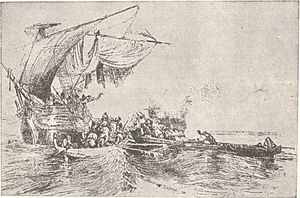Aegean Anti-Piracy Campaign
| Aegean Sea Anti-Piracy Operations | |||||||
|---|---|---|---|---|---|---|---|
| Part of Piracy in the Mediterranean | |||||||
 Greek pirate boats attacking the HMS Comet, which led to intervention by the USS Porpoise after departing its convoy |
|||||||
|
|||||||
| Belligerents | |||||||
|
|
Greek Pirates | ||||||
| Commanders and leaders | |||||||
|
|
Unknown | ||||||
| Strength | |||||||
| 1 ship-of-the-line 1 frigate 3 sloops-of-war 2 schooners 1,990+ sailors and marine infantry |
|||||||
| Casualties and losses | |||||||
| Unknown | 96 killed | ||||||
Aegean Sea Anti-Piracy Operations began in 1825 when the United States government dispatched a squadron of ships to suppress Aegean Greek pirates. Due to the Greek civil wars and the decline of the Hellenic Navy, the Aegean quickly became a haven for pirates who sometimes doubled as privateers. American merchant vessels were attacked, so the Mediterranean Squadron began escort and patrol duties. The operations terminated in 1828 as piracy ceased.
In the wake of the Hellenic Navy's decline after 1824, the Navy turned increasingly to privateering. With the breakdown of law and order in the Aegean, piracy became widespread. Several American merchant ships were plundered by 1825, so that year President James Monroe sent Commodore John Rodgers to protect American commerce. From 1825 to 1828, seven American warships were assigned to the Mediterranean Squadron, including the flagship USS North Carolina, the frigate USS Constitution, the sloops USS Fairfield, USS Lexington and USS Ontario, and the schooners USS Porpoise and USS Warren. The sloops and schooners were the main vessels deployed against the pirates because the larger men-of-war were too large to be effective. Many of the Greek pirates used small, three-masted vessels called mistikos and were usually armed with one bow gun.
...
Wikipedia
